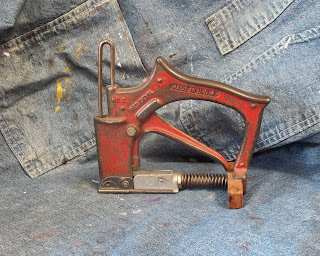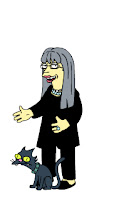Part One
On this very day in 1969 I began what has resulted in a most satisfying
and creative journey of fifty years (and counting).
I was 23 years old, and other than babysitting in high
school, selling my own artwork at outdoor art and craft shows, as well as a brief
stint as an unenthusiastic purveyor of Parklane jewelry at home parties, I had
never been employed in a real job. I was
bored.
One day I found a classified ad in a Buffalo paper – it listed
an address on Allen Street and stated “Must be artistic.” Figuring I would be a shoo-in, I strolled
into the little gallery at around 3 o’clock in the afternoon. I was greeted by an overenthusiastic Weimaraner
(I believe his name was "Get down, Axel!") and the quintessential grumpy old man. I told the man I was there for the advertised
job.
“You should have been here this morning at 9 o’clock!” he
shouted, “I already hired someone.” I was
a bit taken aback by his outburst, but the place seemed interesting, so as long
as I was there, I began looking around.
The ad had only mentioned the street address, not the name of
the business, and I had not noticed the name when I had entered. As I was nosing around I found business
cards which read “Buffalo Picture Frame & Mirror.”
“This is Buffalo Picture Frame?” I blurted. The man looked at me as if I had taken leave
of my senses.
“My uncle works at Buffalo Picture Frame,” I continued
lamely.
He started, and then in a voice dripping with suspicion, growled, “Who’s
your uncle?”
“Bob McPherson,” I replied.
Uncle Bob had worked there for many years.
“Bob didn’t tell me his niece was looking for a job!” he exclaimed. He took a few seconds to reconsider the situation and then then asked me for my phone
number in case his new hire did not pan out.
And that is how I met the inimitable Jason S. Natowitz – Army
sharpshooter, pharmaceutical salesman, accredited inventor of department store Santa
photographs, and the founding father of the Allentown Art Festival. He was a man of many talents.
Jason phoned me the next morning and instructed me to report
for work the following Monday. Turns
out the woman he had hired had never even gotten off of her bus when she saw
the old boarded-up building on William Street.
Not exactly the trendy Allentown address where either of us had expected
to be working.
I started at minimum wage, $1.55 per hour, and I envisioned
being able to spend this small fortune on expanding my horse collection. My first week’s pay did indeed go to the
acquisition of a beautiful Italian alabaster horse head that I had spied in the
window of a cluttered little antique store across the street from Jason’s
gallery.
From then on my wages went for household expenses and new
horses were few and far between.
I barely noticed, however, because as the horses were shelved, the love of picture
framing took over my life.
The first mystery I was initiated into was how the picture is
installed into the frame. I was put to
work at the fitting table. There I
learned to clean the glass, use the ancient Red Devil diamond point driver to
fasten the framing package into the frame, and apply paper and screw eyes and
wire to the back.
 |
| It still works and I use it when no other tool will do the trick. |
Soon I was cutting the backing boards, and then dry mounting
was added to my duties, and finally the Holy Grail – mat cutting on the Keaton
Kutter and the Springfield oval cutter. I was also taught how to cut
glass by hand and eventually how to cover mats and liners with beautiful silks,
linens, and velvets.
Jason had bought the business in the fifties and in those
days framers did not deign to share trade secrets so he was pretty much on his
own, making things up as he went along.
When he encountered a problem, he engineered a solution – he was a
creative genius and even with the non-archival materials available to us back
then, a great designer and picture framer. Granted,
some of the techniques he devised would cause a modern framer to faint dead away
– but he tried his best.
I still use many of Jason’s techniques today. Fifteen years ago I attended a fabric
workshop presented by our industry’s top fabric guy, and I was astounded to be
shown Jason’s exact process, step by step.
The only difference was modern fabric glue instead of generic white
glue, and rag matboard instead of wood pulp board.
 |
| Jason S. Natowitz and Darryl's predecessor, Jay, early 70's. |
Despite the dank windowless firetrap we were working in, the
gang of us got along remarkably well.
Ceil, the previous owner-turned-bookkeeper guided us when she could in
the front and provided delicious cakes for birthdays and holidays. Helga was the other fitter, Lance (aka “Sinus”)
was our often-absent Manager, and my Uncle Bob worked upstairs restoring
paintings alongside the talented but color-blind Bruno who gold-leafed and
finished length moulding.
There were several guys who worked in the back room, cutting
and joining frames. They came and went
but after Lance departed, Darryl became the Manager, and we had fun almost
every day, especially when Jason was not fussing over our shoulders and stinking up the place with his disgusting cigars. Fortunately, he spent most of his time on
Allen Street and only came to the workshop to pick up and drop off orders.
I worked there until the end of 1971 because, thanks to the
glass guy, I was recruited away to work at Bond’s in Williamsville. But that is another story.
. . . to be continued . . .



